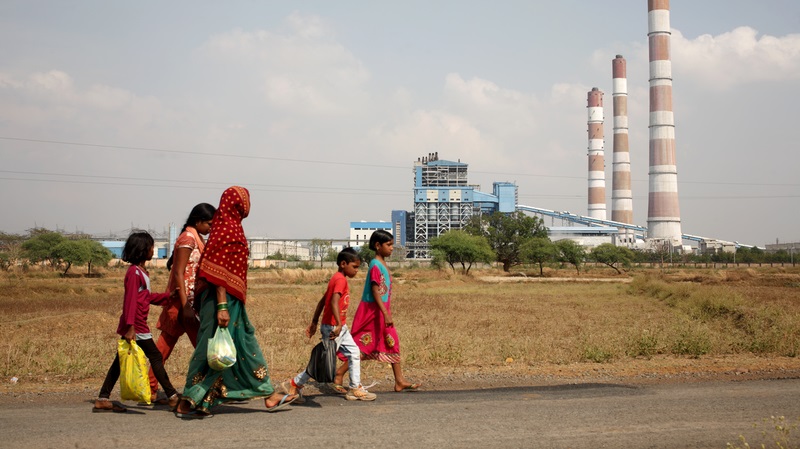More than a year ago, leaders of the G7 group of big wealthy countries announced they were working on a series of deals to move emerging economies away from fossil fuels, particularly coal.
With South Africa’s Just Energy Transition Partnership (JETP) already underway, they said at the summit in Germany that they were negotiating with Indonesia, Vietnam and India.
Since then, Indonesia and Vietnam have signed JETP deals — but not India. Experts familiar with the issue said that no Indian deal is expected in the near future.
Swati D’Souza, an energy analyst with the Institute for Energy Economics and Financial Analysis (IEEFA) said that for a number of reasons, “there is considerable resistance within India [to the JETP]”.
Those reasons include the JETP’s emphasis on phasing out coal, which is the mainstay of India’s energy mix, and the relatively small amount of financing involved, as well as the debt nature of that finance.
There is also scepticism about adding a new and parallel negotiation on climate funding, when old ones haven’t come to much, says D’Souza.
A distraction
At the UN climate talks, India has repeatedly but unsuccesfully urged wealthy countries like the G7 to fulfil their promise to provide $100 billion a year in funding for developing countries to help tackle and adapt to climate change.
Ultimately, the JETP is seen as a political statement that will be played as a win for G7 countries seeking to show they are helping developing nations wean off fossil fuels.
But it won't necessarily be seen as a win for India, especially ahead of national elections next year. “If India has to make a political declaration, what are the returns for it?” asks D’Souza.
A key obstacle appears to be the JETP’s emphasis on coal. The deals with South Africa, Indonesia and Vietnam focused on transitioning energy systems away from coal power towards renewables.
But India has long resisted deadlines for ending use of this fossil fuel - famously changing the phrase “phaseout” of coal to “phasedown” at the Cop26 talks at Glasgow.
No transition from coal
The government argues that coal is needed to meet the growing energy demands of its developing economy and the fuel is being unfairly singled out while the oil and gas on which developed nations rely are spared.
Santosh Agarwal, deputy director general of the ministry of coal, reiterated that position last month.
Delivering a lecture on the just transition, her first statement was: "As far as India is concerned, transition away from coal is not happening in the near future."
Coal provides more than 70% of India's electricity - a figure the government predicts will come down to 55% by 2030 as the share of renewables rises.
Because of India's growing population, economy and energy demand, a drop in the percentage doesn't mean using less coal in absolute terms. Agarwal said coal demand would rise by about 40% by 2030 and only peak in 2040.
India plans to produce more coal too to meet this rising demand. It has a target to increase coal production from 900 million tons to 1.5 billion tons by 2030.
Agarwal said there would be “no closure of mines because of just transition” and indeed "mega-mines" would open, creating jobs.
Independent analyses found there is potential to close some loss-making mines and some new coal power plants may be unneeded.
India has the second-largest plans to build coal plants in the world, after only China. Yet “many plants are under-utilised,” says Ashwini Swain, an analyst with the Centre for Policy Research in New Delhi.
But the growth projections mean India won’t see job losses in coal in the near future, making funding to retrain coal workers unnecessary.
D’Souza also notes that most of the 13-20 million Indians working in coal and allied industries are informal workers who may not be covered by a JETP-style program.
Terms not attractive
Sandeep Pai is an energy analyst and director of Swaniti Initiative. He said that the size and type of funding on offer is an obstacle to a JETP for India.
The public money on offer was around $8.5 billion for South Africa, with similar amounts for Indonesia and Vietnam. Pai describes these figures as very small for a country of India's size.
Rich countries sink billions into oil and gas despite Cop26 pledge
These are amounts that India can leverage from the commercial markets on its own, said Pai. According to one estimate, India will need some $900 billion over 30 years to meet its renewable energy targets.
“The first six months or so [after the JETP negotiations last year], Indian stakeholders were trying to understand what the G7 was talking about,” Pai says, adding, “Now they understand, and we are not very interested.”
Much of the money on offer to South Africa and Indonesia has been in the form of loans not grants. This has proved controversial in both nations, with critics saying the governments are adding to the nations' debt piles.
Different JETP needed
Despite the hurdles though, the JETP process could be useful for India in stimulating a conversation around just transition, as it did in South Africa, says Pai.
And the recent addition of Senegal, which is not a major coal user compared to the other countries, suggests these partnerships don’t have to focus on coal.
Mexico’s ruling party picks climate scientist for presidential run
Instead, the focus could be on India’s own agenda of expanding renewable energy, says Swain. The country has committed to almost triple the amount of non-fossil fuel electric capacity from around 180 GW today to 500 GW by 2030.
Or it could look at how to offset some of the negative effects of coal. “If we recognise India’s reliance on coal for at least the next few decades, we can talk about how that coal can be cleaner, or finance for restoring ecology after a mine closure,” says Swain. “There has to be a separate model of JETP for India.”
